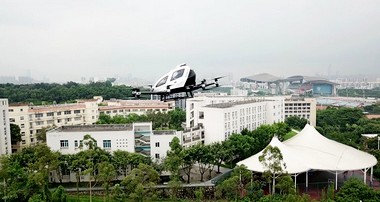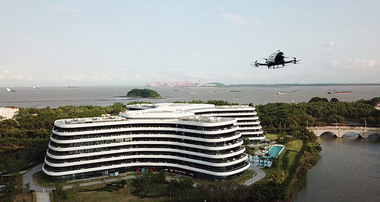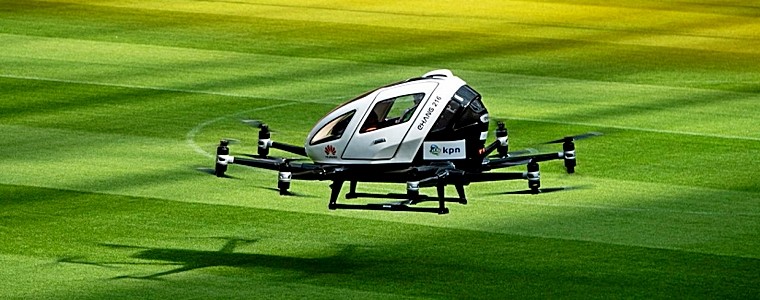EHang approved to conduct commercial logistics flights

EHang is a dominant player in the quadcopter drone market. The company hopes to extend its unmanned electric VTOL technology to manned applications. The EHang 216 is based on the EHang 184, yet it has eight arms instead of four. This allows for the vehicle to be seat two passengers instead of just one.

The EHang 184 with four arms on which the 216 is based.
 
The 184 during test flights.
The EHang 216 Autonomous Aerial Vehicle ("AAV") was first announced in February 2018. Manned and unmanned flight testing was conducted in China in 2017, and a manned flight test with Dutch prince Pieter Christiaan took place at the Amsterdam ArenA in April 2018.

The EHang 216 Autonomous Aerial Vehicle ("AAV") was first announced in February 2018.
In a July 2017 interview for CNBC, EHang co-founder Derrick Xiong stated that "at this moment we are working closely with Dubai and we have actually, together with them, have done numerous tests internally. Also, we have basically done a lot of - many, many times - tests with a passenger on it, including the vice-mayor of Guangzhou City in China and also some governors from Dubai as well. We have done a lot of tests and we aim to do the very first public demo very soon this year."
As of July 2018, the 216 has made over 1,000 manned flights by July 2018 and has traveled 8.8 km on a single trip.
In April 2019, EHang advertising states "Welcome to the Urban Air Mobility Project" and that their starting point will be Austria. Their vision: "To establish a human-focused, sustainable way for people to get about in the future. We seek to create shortcuts - so transport is no longer restricted by roads. Shortcuts that will allow nature to reconquer areas now occupied by concrete and traffic jams. Shortcuts that offer each person more freedom to move in urban space."

As of July 2018, the 216 has made over 1,000 manned.
According to an April 16, 2019 interview with Urban Air Mobility Magazine, getting to regular production involves two (2) stages. Stage one (1) is making several hundred copies for testing in multiple countries around the world. Stage two (2) building the aircraft in large numbers. Their partners now include FACC (a global technology leader of designing, developing and manufacturing lightweight systems for the aerospace industry) located in Austria and ProSiebenSat.1 PULS 4 group for their branding the EHang product. Both companies are located in Austria.

As of January 2020, over 2,000 passenger flight tests have taken place in the 216.
The EHang eVTOL aircraft have proprietary in-flight operating systems. The autopilot and flight control system gathers data from accelerometers, gyroscopes, a magnetic compass, barometers, visual sensors, global navigation satellite system (GNSS) receivers, millimeter wave radars and more, using this information to make intelligent navigation decisions. Other systems include communications, battery management and safety management with support coming from the EHang Command Center.
As of January 2020, EHang has reported that for the EHang 216 aircraft, over 2,000 passenger flight tests have taken place including flying in winds up to 70 km/h (44 mph), in fog and with low visibility situations which have been around 50 m (164 ft). EHang is also seeking U.S. Federal Aviation Administration (FAA) approval for their aircraft and their first U.S. flight test took place in January 2020.

EHang has also designed multiple types of E-Ports allowing rooftop landings.
EHang has also designed multiple types of E-Ports allowing rooftop landing on tall buildings with interior automated storage. E-Ports have been designed for buildings with large and small roof areas. E-Ports have also been designed for ground and water-based landing facilities as well
The Civil Aviation Administration of China (CAAC) has approved eVTOL aircraft developer EHang to conduct commercial logistics flights using its 216 Autonomous Aerial Vehicle on behalf of a hotel operator at Taizhou in southern China. EHang claims this is the world's first commercial pilot operation to be approved by a national aviation authority and the permission has been granted even though the all-electric EHang 216 has not yet completed type certification.

EHang will carry loads such as luggage or groceries for an unnamed client.
The approval, which was announced on 27 May 2020, follows earlier interim approval granted in February 2019 for trial operations for the Model 216, including some that have carried passengers. None of these flights, made at a number of locations in China, were conducted on a commercial basis.

EHang hopes to get approval to carry hotel guests on sightseeing flights.
EHang will carry loads such as luggage or groceries for its unnamed client between several sites in the Taizhou area, including a hilltop location and a nearby island. The 216 can carry a payload of up to 485 pounds, consisting of freight or up to two passengers.
The manufacturer said it hopes to get approval to carry hotel guests on sightseeing flights. Earlier this month, it signed an agreement with Guangzhou-based LN Holdings to develop tourist flight services at several of the company's hotels in China.

|
       |























